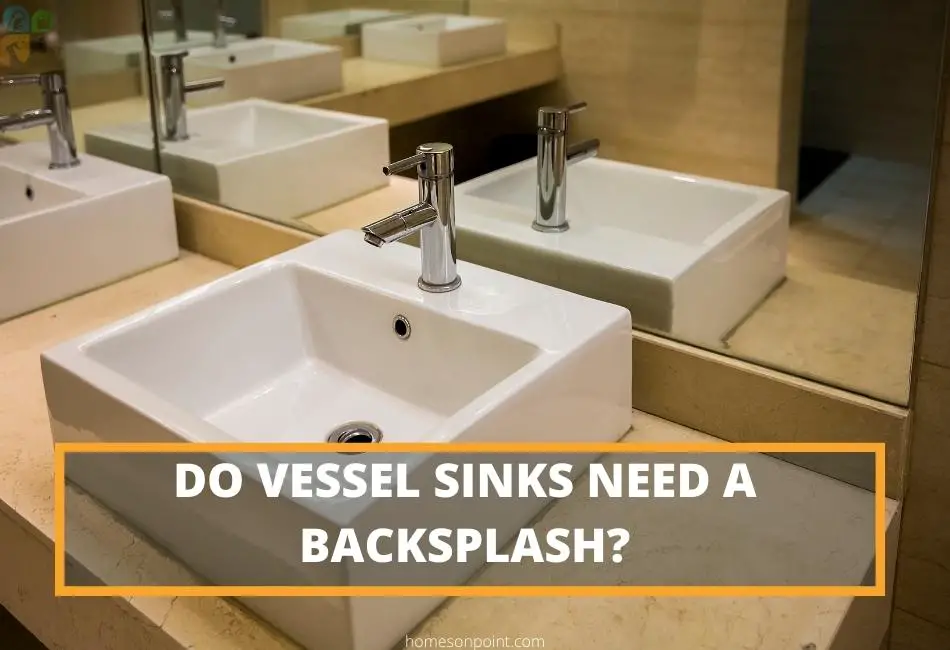Sinks are essential items in the household. From bathrooms to kitchens, the importance of sinks cannot be overemphasized. As much as some people may not be overly concerned about which type of sink is fitted in a space, it is imperative to know which options are available and how they function.
A vessel sink is one of the sleek options available when it comes to sinks. It is an artistic free-standing bowl or sink that sits on top of a counter, either resting on top of the vanity surface or recessed partially for support.
Vessel sinks do not necessarily need a backsplash. But while backsplashes are not absolutely necessary, they can go a long way in protecting your bathroom walls from water damage.
What Is A Sink Backsplash?
A sink backsplash is a decorative panel installed behind a sink to protect the wall behind the sink from water damage such as rot, warp, mold, and mildew. Backsplash takes accidental water splashes from face and hand washing, tooth brushing, etc so that the drywall behind the sink will not collect moisture.
The standard size of a sink backsplash is normally 4 inches from the countertop. However, some sink backsplashes extend up to 8 inches.
Backsplashes are typically made of materials that are easy to clean and resistant to stainings, such as ceramic tile, stainless steel, or glass. Many backsplashes also incorporate design elements such as color or pattern, making them a key part of the overall kitchen décor.
Importance Of Having A Sink Backsplash
The importance of a sink backsplash is essentially heavily based on its function. As I stated earlier, a backsplash is a protective covering. This leads us to the prime importance of a sink backsplash.
1. To Protect The Drywall Behind The Sink
The most important thing a sink backsplash does is to protect the wall behind the sink from water damage. The backsplash extends above the sink and protects the wall from any water that may splash out of the sink. This is especially important in a bathroom where there are many opportunities for water to splash out of the sink. As much as the drywall damage may not occur suddenly, it would happen with time.
What happens is that any time water splashes on the wall behind your sink and you may have forgotten to wipe it off, it causes some form of damage. If this persists, before you know it, your wall will develop mold or mildew and this in itself is a form of health hazard.
Backsplash simply can help prevent expensive water damage repairs.
2. Helps Keep The Bathroom Clean
A sink backsplash helps keep your bathroom clean by preventing chemicals and other liquids from splashing up onto the walls. The backsplash creates a barrier between the sink and the wall, which helps keep liquids and stains from getting onto the wall. This can help keep your bathroom looking clean and tidy and reduce the amount of cleaning you have to do each day.
3. Adds Visual Interest To The Bathroom
If aesthetics is something that you hold in high esteem, you may choose to have a sink backsplash just to spruce up your space. Backsplashes add some elegance and character to spaces.
The backsplash creates a focal point behind the sink and helps make the space more visually appealing. A sink backsplash can also be used to add color or pattern to your bathroom décor, making it a fun way to add personality to your space.
Is A Backsplash Needed For Vessel Sinks?
While many people believe that backsplashes are a necessary component of vessel sinks, the truth is that they are not required. Whether you need a backsplash or not may be dependent on these factors below:
1. Style
I acknowledge that style may be subjective. However, for this explanation, I will be using traditional as against contemporary style. A backsplash can be unique to add some oomph to a traditional-looking space. However, with a modern style, you would have no need for a backsplash.
We can all agree that vessel sinks are a contemporary style. As such, there will be no need for a backsplash. This is because, with contemporary style, the focus is on clean lines and a minimalistic approach. So, the addition of a backsplash may actually take away from the sleek look you are trying to achieve.
2. Use Of The Sink
The way you use your sink will also help you determine if you need a backsplash or not.
If you are someone who systematically uses your sink and never lets any water splash out, then you likely will not need a backsplash.
However, if you are someone who is often using the sink for tasks such as washing items (which almost always results in the water splashing out of the sink), then you may need a backsplash to protect your walls from water damage.
There is also the frequency at which the vessel sink is used. Most people fit vessel sinks in their guest washrooms and they are also common in hotel bathrooms.
Guest bathrooms may not be used very often and as such there may be no need for a backsplash. On the other hand, hotel bathrooms may be used more often so there may be a need for a backsplash.
The frequency of use of a vessel sink also ties in with the maintenance of the backsplash if there is any. By this, I mean, if the wall behind the sink cannot be wiped regularly, a backsplash would be good to have as it would prevent water damage to the drywall.
3. Size Of Vessel Sink
Sometimes, the size of the vessel sink can be a factor in deciding whether or not a backsplash is needed. Vessel sinks require faucets that a slightly different from the standard ones. If the faucet is placed higher, it is likely that there will be more splashes of water. In this case, a backsplash would be needed.
Ideally, the faucet spout for a vessel sink should be directly over the drain or in the center of the sink basin. If this is not paid attention to, there may be more water splashes.
From what I have explained, if the vessel sink is bigger, the splashes may be reduced and a backsplash may not be a necessity. On the other hand, if the vessel sink is smaller, it will imply more splashes and thus, the need for a backsplash.
4. Budget
Finally, backsplashes can be expensive. If you are on a tight budget, you may not want the extra expense of having to buy and install a backsplash so skipping the backsplash may be the best way to keep costs down
On the other hand, if you have a little bit more to spend, you may want to consider adding a backsplash as it can add some extra personality to your space.
Some Backsplash Ideas For Vessel Sinks
If you have decided that you would like to add a backsplash to your vessel sink, here are some ideas to get you started:
1. Tiles
When it comes to tiles, the options are endless.
Subway tiles are classic, timeless, and customizable. They are simple and elegant and come in a variety of colors. You can even choose to mix and match different colors to create a unique look.
Glass tiles give an elegant and sophisticated look. They also create an illusion of a large space while you get a customized look.
Stone tiles are another popular choice for backsplashes. They are durable, easy to clean, and come in a variety of colors and textures. They can add a luxurious feel to your space.
Ceramic tiles are another option. They are less expensive than stone or glass tiles but they are just as durable and easy to clean.
Mosaic tiles add a touch of artistic elegance. You can choose any of these tiles as a backsplash for your vessel sink.
2. Mirrors
Yes, a simple mirror can be used as a backsplash for a vessel sink. A mirror backsplash is a great way to make your space appear larger. It also reflects light and brightens up the space. You must however be prepared to wipe off water splashes from the surface of the mirror whenever the sink is used. Mirrors can be classy too.
3. Wallpapers
Alternatively, you can use water-resistant wallpaper as a backsplash for your vessel sink. This option is cheap and easy to install. You can find wallpapers in a variety of colors and patterns. Just make sure that the wallpaper is water-resistant as you don’t want it to peel off every time the sink is used.
4. Wood
Wood is another great material that can be used as a backsplash. It gives a warm and natural look to the space. You can use reclaimed wood or simply install some wooden boards horizontally or vertically. Just make sure that the wood is sealed properly so that it is waterproof.
This style works very well if you want to go for a rustic or farmhouse look.
Final Words
I hope this article has helped you understand whether or not vessel sinks need a backsplash. I have listed some factors that you need to consider before making a decision. I have also shared some backsplash ideas in case you decide to add one.
So, what are you waiting for? Go ahead and pick the perfect backsplash
Do remember that a backsplash is not a necessity but it can definitely add some personality and style to your space.

